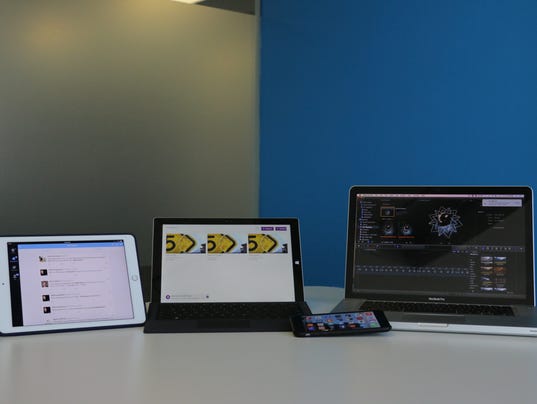
LOS ANGELES — Raw clips may work for tornado videos, but a citizen journalist with bigger ambitions needs to know how to edit.
In part 1 of this series, we showed you how to shoot broadcast-quality video on your smartphone with tools like microphones, tripods and selfie sticks. With the availability of smartphones and tablets with improved built-in cameras, anyone can now be a mobile journalist.
So now what? You want to take your raw clips, trim them, add titles and edit them in a quick masterpiece. And now we've all got portable computers in our pockets to do this, thanks to the smartphone.
Mobile editing will get the job done with the most basic of edits. I prefer to have the big screen and way more controls of the laptop, so I do most of my work there.
But that's me. Judd Slivka, who teaches mobile journalism classes at the University of Missouri, has his students do all their shooting and editing on mobile tools to speed up the process. "It cuts 25% of the time it takes to shoot and edit and get it done," he says.
HOW TO GET THE CLIPS OFF
Before we jump into mobile editing, let's take a quick minute to figure out where to find our footage, and how to get it off the devices.
On Apple devices, video clips are found in the "Camera Roll," or "Photo" app, while recent Androids house them in the "Photos" app.
Now say you want to shoot on the iPhone, but edit on the iPad. Or, you want to send your clips to a pal, who's an editor. Or, you bought a 16 GB iPhone, thinking it would have enough storage, only to realize that 8 GBs of it is taken up with the iOS operating system, and that there's just no room for your video files. You want to be able to move the files around.
Many think they can email the clips, and that will save the day. Not true. To fit the clips in the email, the resolution will be lowered and it won't be usable for your presentation. One easy solution: a cloud service like Dropbox is a great workaround for anyone with an Apple phone, since there's a direct Dropbox link in the Photos app. There's also Apple's AirDrop for sending files wirelessly from Apple devices. Many Android phones have slots for memory cards so the footage can go direct onto the cards. That's something the iPhone doesn't have.
For iPhone and iPad users, Slivka recommends the $59.99 Air Stash drive to his students. This is a wireless device that allows for transferring of files from device to device.
• Smartphone. Since you're shooting on the phone, the obvious first choice is to edit there. The limitations are the size of the screen — 4 inches to 5.5 inches, and less computing power than a laptop or desktop. But it certainly can be done.
If you have an iPhone, you'll want to start with Apple's iMovie, (free), which offers the basics: trimming, adding titles and a voice-over tool. There are many other decent options available now for either an automatic edit — sit back and let the computer do the work — or a more hands-on, manual approach.
Pinnacle Studio ($7.95) has more controls and choices than iMovie. A new app, Clips Video Editor, (free, Apple, with in-app purchases) is one of the more intuitive of the mobile video editors I've found, and promises to get more full-featured later this year. For Android, there aren't as many serious options. VivaVideo is one of the most popular, while Windows Phones has the new Movie Creator.
Read more: How to edit and share video as a citizen journalist
Thank You For Sharing This Post With Us This one is Really Helpful..!
ReplyDeletehttps://worldfree4u.com/
worldfree4u.com
worldfree4u.com 300MB
full movie worldfree4u